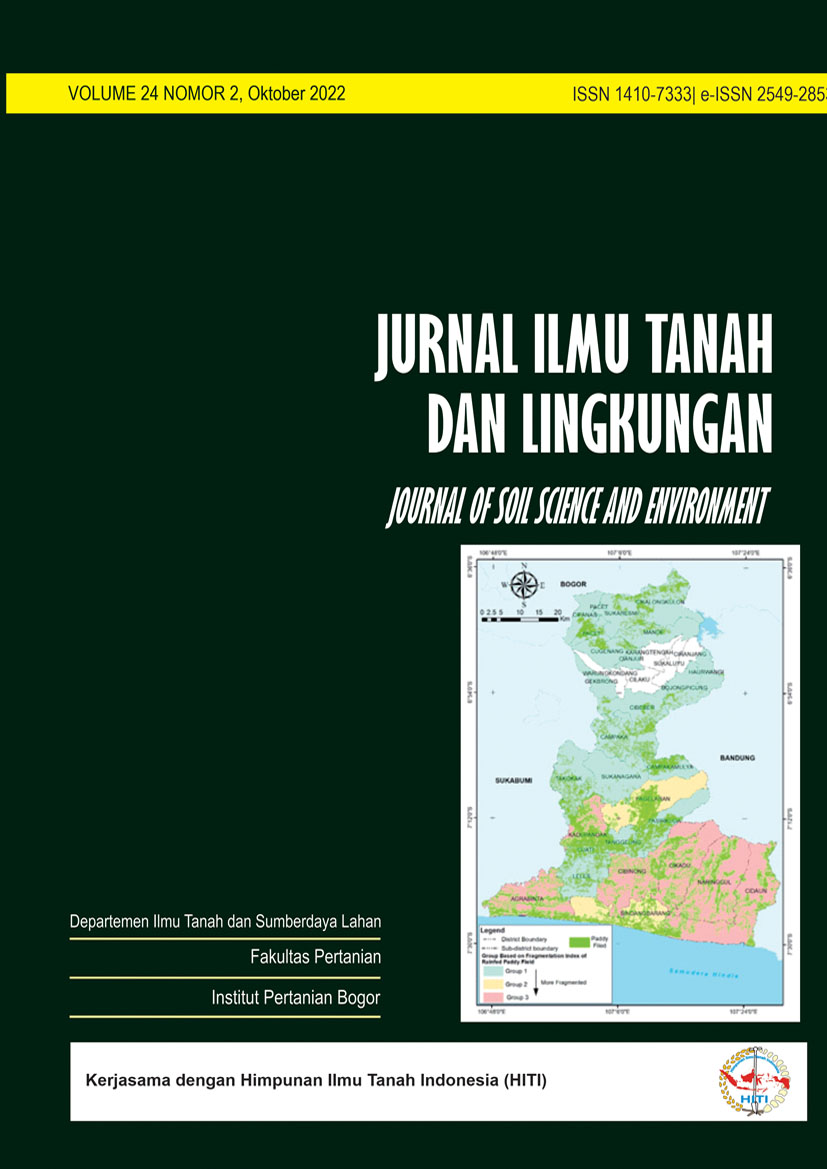Application of Biochar and Biofertilizer Combination on Corn in Up Land Pandeglang Regency
Aplikasi Kombinasi Biochar dan Pupuk Hayati pada Tanaman Jagung di Lahan Kering Kabupaten Pandeglang
Abstract
Biochar is an alternative amendment for improving soil is to rehabilitate degraded land, especially dry land. In addition, biochar serves as a habitat for soil microbes that play an important role in the availability of nutrients for plants. The use of biofertilizers in agriculture is part of the support for sustainable agriculture because it is environmentally friendly. This study aimed to examine effect of application biochar and biofertilizers combination on chemical and biological properties of soil as well as growth and yield of maize in an up land, Pandeglang Regency. The experimental design in this study was a factorial completely randomized design with two factors. The first factor was biochar with 3 levels (0; 2.5; 5 tons ha-1) and the second factor was combination of biofertilizer (PHC) and NPK with 5 types (100% PHC, 100% NPK, 25% PHC + 75% NPK, 50% PHC + 50% NPK, and 75% PHC + 25% NPK). Each treatment was replicated 3 times so there were 45 experimental units. The results of this study showed that the application of biochar dose of 5 tons ha-1 (B2) significantly increased K-available in soil and plant height. The combination of 75% biofertilizer and 25% NPK (P4) significantly increased the population of N2-fixing bacteria and cellulolytic bacteria. The combination of biochar dose 2 with 100% NPK fertilizer (B2P1) is the best treatment combination in improving soil nutrient status. On the other hand, the combination of application of biochar dose 1 (2.5 ton ha-1) with 50:50 concentration of biofertilizer and NPK (B1P3) has the opportunity to support the growth and yield of maize.
Downloads
References
Ajema, L. 2018. Effects of biochar application on beneficial soil organism review. Int J Res Stu Scie, Eng Tech., 5(5): 9–18.
Anderson, C.R., L.M. Condron, T.J. Clough, M. Fiers, A. Stewart, R.A. Hill and R.R. Sherlock. 2011. Biochar induced soil microbial community change: implications for biogeochemical cycling of carbon, nitrogen, and phosphorus. Pedobiologia, 54(5–6): 309–320.
Chan, K.Y., L.V. Zwietter, I. Meszaros, A. Downie and S. Joseph. 2007. Agronomic value of green waste biochar as a soil amendment. Aust J Soil Res., 45: 629–634.
Dil, M., M. Oelbermann and X. Wei. 2014. An evaluation of biochar pre-conditioned with urea ammonium nitrate on maize (Zea mays L.) production and soil biochemical characteristics. Can J Soil Sci., 94: 551–562.
Dinas Pertanian Kabupaten Pandengan. 2020. Sasaran dan Realisasi Intensifikasi Tanaman Pangan tahun 2020. Pandeglang: Dinas Pertanian Kabupaten Pandeglang.
Hale, S.E., V. Alling, V. Martinsen, J. Mulder, G.D. Breedveld and G. Cornelissen. 2013. The sorption and desorption of phosphate-P, ammonium-N and nitrate-N in cacao shell and corn cob biochars. Chemosphere, 91(11): 1612–1619.
Kumar, R., N. Kumawat and Y.K. Sahu. 2017. Role of biofertilizers in agriculture. Popular Kheti, 5(4): 63–66.
Lehmann, J., J. Rillig MC, Thies, C.A. Masiello, W.C. Hockaday and D. Crowley. 2011. Biochar effect on soil biota – a review. Soil Biol Biochem., 43: 1812–1836.
Liu, S., Y. Zhang, Y. Zong, Z. Hu, S. Wu, J. Zhou, Y. Jin dan J. Zou. 2016. Response of soil carbon dioxide fluxes, soil organic carbon, and microbial biomass carbon to biochar amendment: a meta-analysis. GCB Bioenergy, 8(2): 392–406.
Liu, S., J. Meng, L. Jiang, X. Yang, Y. Lan, X. Cheng and W. Chen. 2017. Rice husk biochar impacts soil phosphorous availability, phosphatase activities and bacterial community characteristics in three different soil types. Appl Soil Ecol., 116: 12–22.
Nurida, N.L. 2014. Potensi pemanfaatan biochar untuk rehabilitasi lahan kering di Indonesia. J Sumberdaya Lahan. Edisi khusus: 57–68.
Praing, M.W., Y.P. Situmeang and I.B.K. Mahardika. 2018. Penggunaan berbagai jenis biochar dan jenis pupuk dalam meningkatkan pertumbuhan dan hasil tanaman jagung manis. Gema Agro., 23(2): 176–181.
Sandiwantoro, R.T., W.E. Murdiono and T. Islami. 2017. Pengaruh sistem olah tanah dan pemberian biochar pada pertumbuhan dan hasil tanaman jagung manis (Zea mays saccharata Sturt.). J Produksi Tanaman, 5(10): 1600–1607.
Santosa, E. 2007. Mikroba pelarut fosfat. Di dalam: Saraswati R, Husen E, Simanungkalit RDM (Eds). Metode Analisis Biologi Tanah. Bogor: Balai Besar Penelitian dan Pengembangan Sumberdaya Lahan Pertanian. 39–52 pp.
Saraswati, R., T. Prihatini and R.D. Hastuti. 2004. Teknologi pupuk mikroba untuk meningkatkan efisiensi pemupukan dan keberlanjutan sistem produksi padi sawah. Di dalam: Agus F, Adimihardja A, Hardjowigeno S, Fagi Am, Hartatik W (Eds). Tanah Sawah dan Teknologi Pengelolaannya. Bogor: Pusat Penelitian dan Pengembangan Tanah dan Agroklimat. 169–189 pp.
Steinbeiss, S., G. Gleixner and Antonietti. 2009. Effect of biochar amendment on soil carbon balance and soil microbial activity. Soil Biol Biochem., 41(6): 1301–1310.
Tang, J., W. Zhu, R. Kookana and A. Katayama. 2013. Characteristics of biochar and its application in remediation of contaminated soil. J Biosci Bioeng., 116(6): 653–659.
Yu, O.Y., R. Brian and S. Sam. 2013. Impact of biochar on the water holding capacity of loamy sand soil. Int J Energ., Environ Eng., 4(44): 1–9.
Copyright (c) 2022 Jurnal Ilmu Tanah dan Lingkungan

This work is licensed under a Creative Commons Attribution-ShareAlike 4.0 International License.
Department of Soil Science and Land Resources Departemen Ilmu Tanah dan Sumberdaya Lahan, Faculty of Agriculture Fakultas Pertanian, IPB University



















